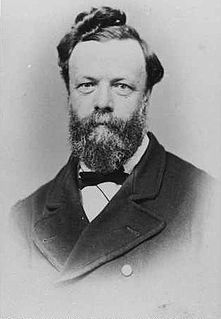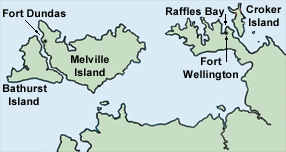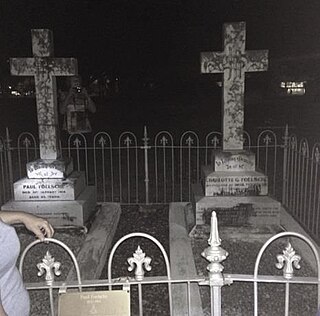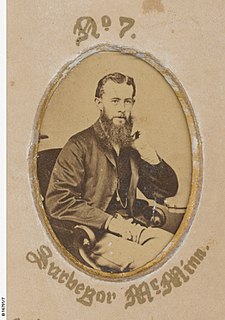
Nightcliff is a northern suburb of the city of Darwin, Northern Territory, Australia.

George Woodroffe "Bud" "Little Energy" Goyder was a surveyor in the Colony of South Australia during the latter half of the nineteenth century.

Fort Dundas was a short-lived British settlement on Melville Island between 1824 and 1828 in what is now the Northern Territory of Australia. It was the first of four British settlement attempts in northern Australia before Goyder's survey and establishment of Palmerston, now known as Darwin. The three later attempts were at Fort Wellington, Port Essington and Escape Cliffs.

Millner is a northern suburb in the city of Darwin, in the Northern Territory of Australia.

Rapid Creek is a northern suburb of the city of Darwin, Northern Territory, Australia.

Lee Point is a northern suburb of the city of Darwin, Northern Territory, Australia.

Mitchell is a suburb in the Northern Territory of Australia located in the city of Palmerston about 18 kilometres (11 mi) south-east of Darwin City.

Smith Street is a major street in the Darwin Central Business district of Darwin, Northern Territory, Australia. Smith Street is named after A. H. Smith who was the first surveyor in charge of party number 3 of George Goyder in 1869. Smith Street runs 4.5 kilometres in a north-west to south-east direction on the western side of the Darwin CBD. The street intersects with Daly Street, Knuckey Street and terminates with The Esplanade.
SS Ellengowan was a schooner rigged, single screw steamer built by Akers Mekaniske Verksted in Christiania (Oslo) Norway, under her original name, Nøkken. The vessel was powered by sail and a vertical direct acting steam engine. Ellengowan sank at its moorings, unmanned, during the night of 27 April 1888 in Port Darwin and was abandoned. 103 years later, in 1991, she was discovered by divers making it the oldest known shipwreck in Darwin Harbour.
The Moonta Herald and Northern Territory Gazette was a newspaper produced on the vessel SS Moonta that was sailed by George Goyder in 1868 and 1869 from Port Adelaide to Darwin. The aim of the 41-day voyage was to provide an initial survey of what was to become the Northern Territory.

Thomas Boutflower Bennett was an early colonist of South Australia, remembered as a schoolmaster at J. L. Young's Adelaide Educational Institution and at Saint Peter's College.

Escape Cliffs is a place on the northern coast of the Northern Territory of Australia and the site of the fourth of a series of four failed attempts to establish permanent settlement in Australia's Top End. The previous attempts were at Fort Dundas, Fort Wellington and Port Essington. Escape Cliffs lies on the western coast of the Cape Hotham peninsula, and the eastern shore of Adam Bay, near the mouth and estuary of the Adelaide River. It lies about 60 km north-east of Darwin and is located in the Cape Hotham sector of the Djukbinj National Park. There is no road access, though it is sometimes visited by yachts.

Captain Samuel White Sweet was an English sea captain who settled in Australia in 1864, and was involved in the early colonization of the Northern Territory. After the grounding of his ships Gulnare and Wallaroo, for both of which he was held culpable, he turned his interest in photography from a serious hobby and part-time occupation to a profession. Sweet was a pioneer of Australian landscape photography as an art form, and kept abreast of technical advances in the medium.

Darwin Pioneer Cemetery was the first official cemetery opened in Darwin in the Northern Territory. It was originally known as Palmerston Cemetery. The cemetery stands as a testament to the many different cultural groups with different religious affiliations that lived in the early years of the city. Opened in 1865, the first burials took place around 1872 or 1873. The cemetery closed in 1919; however, a number of burials were carried out after its closure including people that were associated with the pioneering families. Overall, about 1,230 burials took place, although 450 burials were not recorded by Births, Deaths and Marriages.
Edwin Stow Berry was a surveyor and explorer, who took a leading part in two important expeditions to the Northern Territory of Australia.

Gilbert Rotherdale McMinnCE, SM, was an Australian surveyor born in Ireland noted for his work in the Northern Territory surveying the Overland Telegraph Line. His middle name is occasionally spelt "Rutherdale".

The Hundred of Goyder is a hundred in the Northern Territory of Australia which was part of the now-lapsed cadastral unit of the County of Palmerston.

Harrison Daniel Packard was a surveyor in the early days of the colony of South Australia. He served at Escape Cliffs under B. T. Finniss, and later under G. W. Goyder at Port Darwin.
A number of survey parties to the Northern Territory were involved in attempts to found a settlement in the Northern Territory during the years 1864–1870. This article describes attempts by the South Australian Government to found a settlement in the Northern Territory, and the people who took part in those ventures. It includes lists of all known participants.

Richard Randall Knuckey, often referred to as R.R. Knuckey and popularly known as Dick Knuckey, was a surveyor on the Overland Telegraph Line in central Australia from 1871 to 1872. He later became Chief Officer at the Electric Telegraph Department in Adelaide.
















